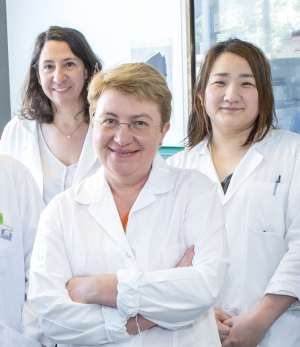
Mariko Okubo is a post-doctoral researcher in the Myology Centre for Research in the « Myomatrix & Myonucleus Related Diseases: Genetics & Pathophysiology » team. She is a Japanese Pediatric Neurologist and came to Paris two years ago. She was awarded the Léa Rose Prize at the WMS annual conference held from 3 to 7 October 2023 in Charleston, USA, for her work on gene therapy in laminopathies. Interview with Mariko Okubo (right), Anne Bertrand (left), the principal investigator of this project dealing with the development of therapeutic approaches in laminopathies, and Gisèle Bonne (middle), the team leader.
What work does the Léa Rose Prize award?
Mariko Okubo. Until last year, it rewarded only SMA projects but in 2023, it was decided to enlarge the field and award the most important contribution on rare genetic disease research.
My project in the team focuses on gene therapy for laminopathies affecting striated muscle, a group of diseases due to mutation in the LMNA gene and presenting muscular dystrophy associated with a cardiomyopathy. They are autosomal dominant diseases, so patients carry one mutated and one wild type copy of the LMNA gene encoding lamin A/C. We already published* pathomechanisms of these striated muscle laminopathies which are due to two causes: the decrease of the global expression of the normal lamin and the expression of a toxic form of mutated lamin. So, the objective of our gene therapy is to decrease the expression of mutated lamin and increase the expression of normal lamin at the same time.
How did you proceed?
MO. In order to reduce mutated lamin A/C expression, we used shRNA** specifically targeting mutated LMNA mRNA. This process is often referred to shRNA knock-down. We also inserted in our therapeutic construct the normal lamin sequence in order to increase the expression of wild type lamin. So, the AAV with genetic construction was injected into heterozygote and homozygote newborn Lmna mutated mice. We examined the cardiac function by echocardiography every month and noticed that the heterozygote mice still suffered from cardiomyopathy.
Anne Bertrand. The normal phenotype of our LMNA mutated heterozygote mice is the development of a dilated cardiomyopathy, and all of them die at 1 year. The idea of the treatment was first to follow by echocardiography the evolution of the cardiac function, and when heart function was too severely affected, to sacrifice the mice to get tissue for molecular analyses. As the mice were injected at 2-3 day-old in the bloodstream, the AAV was distributed throughout the body.
What are the results?
MO. The cardiac function is not improved nor the survival by the gene therapy. But the molecular analysis of the tissues shows that the AAV is not lost over time and we can detect the increase in wild type lamin A (protein and mRNA), but we can’t detect shRNA knock down. So over expression of normal lamin is fine, but shRNA doesn’t work well.
AB. We showed that the lack of efficacy of the treatment is not due to the decrease of AAV in the tissue of the mice. So, we investigated the efficacy of the therapeutic approach by evaluating lamin A expression and we saw a normalization of the expression, meaning that we manage to increase the wild type lamin A expression. Then, we evaluated the second axis of the treatment that is the degradation of the mutant lamin, and we noticed that there is no decrease in mutant lamin A expression. This is due to a defect in shRNA maturation and we have to understand why.
What are the next steps?
AB. First, we need to find out why the step of maturation from shRNA to siRNA is not functioning in these mice. It is something that was not known, but apparently this lamin mutation impact the efficiency of shRNA maturation. So, we discovered a new pathomechanism in this disease.
Gisèle Bonne. In normal cells, shRNAs are matured through a natural process used to regulate the production of proteins. But we had no clue that lamins were playing an important role in that process before. This is just because we have tried to use this non-working machinery that we realized that probably, lamins are important for this natural process.
MO. We have to go around this, to find another way not using this machinery, to reach effects we want to have. This is the work the prize awarded.
* Bertrand et al, Cells 2020. doi:10.3390/cells9040844
** In vivo, to get a permanent expression, we use a shRNA (for « short hairpin RNA »), a small sequence of RNA that forms a loop, and corresponds to a precursor of siRNA (for “small interfering RNA”). SiRNA sequence is complementary to the sequence we want to target, here, the LMNA mRNA. Attachment of the siRNA to the LMNA mRNA interferes with the transcriptional machinery or leads to its degradation hence leading to reduced protein production.
